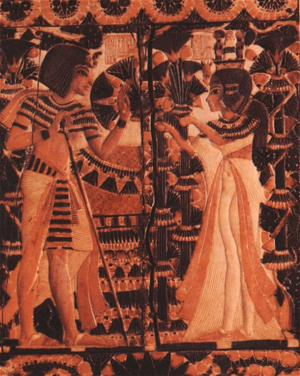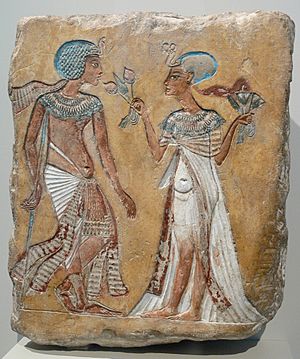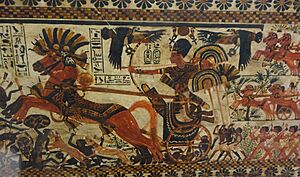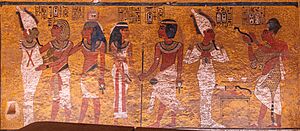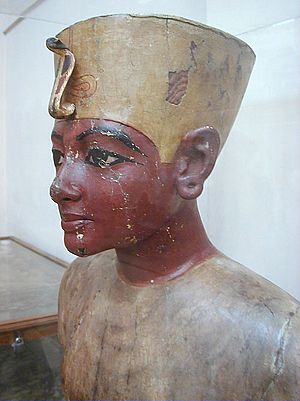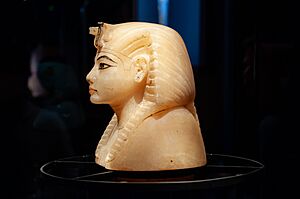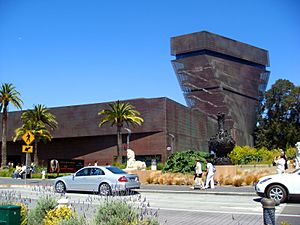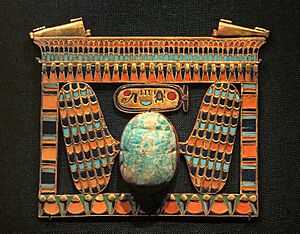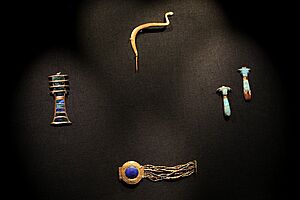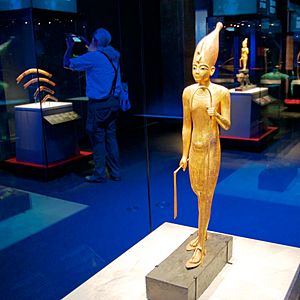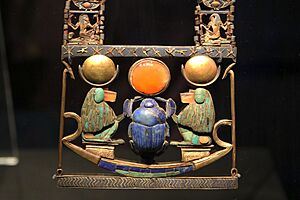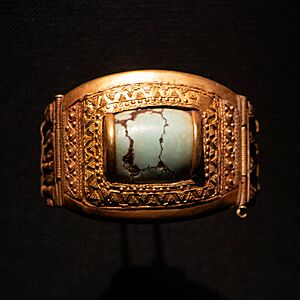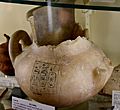Tutankhamun facts for kids
Quick facts for kids Tutankhamun |
|
|---|---|
| Tutankhaten, Tutankhamen, Tutankhamon | |
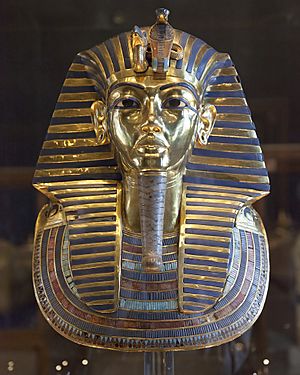
|
|
| Pharaoh | |
| Reign | c. 1332 – 1323 BC, New Kingdom (18th Dynasty) |
| Predecessor | Akhenaten or Smenkhkare |
| Successor | Ay |
| Consort | Ankhesenamun |
| Children | 2 |
| Father | Akhenaten |
| Mother | The Younger Lady |
| Born | c. 1341 BC |
| Died | c. 1323 BC (aged c. 18–19) |
| Burial | KV62 |
| Religion | |
Tutankhamun (pronounced TOO-tən-kah-MOON), also known as Tutankhamen, was an Egyptian pharaoh, or king. He lived a very long time ago, from about 1341 BC to 1323 BC. He ruled ancient Egypt from around 1332 BC to 1323 BC. This was during a time called the Eighteenth Dynasty. When he was born, his name was Tutankhaten.
One of the most important things Tutankhamun did was bring back the old ancient Egyptian religion. In this religion, people worshipped many gods. Before him, a pharaoh had tried to make Egyptians worship only one god, Aten. This change was called Atenism. Tutankhamun helped change things back. This is why his rule is seen as a big "fix-it" time in Egypt's history. He even changed his name from Tutankhaten (meaning "Living image of Aten") to Tutankhamun (meaning "Living image of Amun"). Amun was an important traditional god. His wife also changed her name.
Tutankhamun moved the king's main city from Amarna back to Memphis. He also made friends again with other kingdoms like the Mitanni. He even led his army in battles. He was so important that some people worshipped him as a god while he was still alive. This was rare for kings. He started building his own big tomb in the Valley of the Kings. Sadly, he died before it was finished.
Tutankhamun died when he was only about 18 or 19 years old. Scientists are still trying to figure out exactly why he died. Some think it might have been from malaria and a broken leg. Because his fancy royal tomb wasn't ready, he was buried in a smaller tomb. After him, his advisor Ay became pharaoh. Then, a general named Horemheb took over. Horemheb finished bringing back the old religion.
Tutankhamun wasn't very famous in ancient times. But he's super famous today! This is because in 1922, an archaeologist named Howard Carter found his tomb (called KV62). Even though robbers had broken in long ago, the tomb was still packed with amazing treasures. These included Tutankhamun's mummy and his famous golden burial mask. The discovery made news all over the world. It got people excited about ancient Egypt again. His mask is now a well-known symbol of Egypt. Many of his treasures have traveled to museums worldwide. People often call him by his nickname, "King Tut."
Contents
Tutankhamun's Family
Tutankhamun was born when Pharaoh Akhenaten was ruling. This was during a special time in Egyptian history called the Amarna Period. His first name was Tutankhaten. This name meant "living image of Aten." Aten was the god Akhenaten wanted everyone to worship.
His Parents
It's a bit of a mystery who Tutankhamun's exact parents were. Old writings don't clearly say. We know he was a prince because an old stone piece calls him a "king's son." Most experts think his father was Akhenaten.
Scientists did DNA tests on mummies to learn more. These tests suggest his father was the mummy found in tomb KV55, who is believed to be Akhenaten. His mother was a mummy known as "The Younger Lady," found in tomb KV35. These DNA tests also showed that his parents were related. Both were children of Amenhotep III and his main wife, Queen Tiye.
His Wife and Children
When Tutankhaten became king, he married Ankhesenpaaten. She was one of Akhenaten's daughters. Later, she changed her name to Ankhesenamun. Tutankhamun and Ankhesenamun had two daughters. Sadly, both babies died very young. They were buried with their father in his tomb. CT scans (a special kind of X-ray) showed one baby was born too early. The other was born at the right time but didn't survive. When Tutankhamun died, it was the end of his family's direct line of kings.
What Tutankhamun Did as Pharaoh
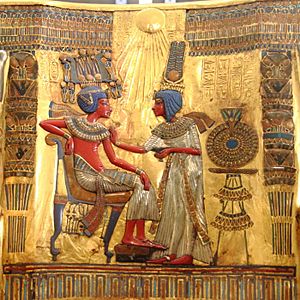
Tutankhamun became pharaoh when he was very young. He was only about eight or nine years old! This was after Akhenaten and one or two other rulers had short reigns. When he became king, Tutankhamun took the special royal name Nebkheperure. He ruled for about nine years.
Because he was so young, older advisors likely helped him make big decisions. One important helper was the Vizier, who was like a prime minister. Ay, who became pharaoh after Tutankhamun, was a very important advisor.
When a pharaoh took the throne, they were given special royal names and titles. These names connected them to the gods and showed their power. Tutankhamun had several of these special names.
Changing Religion Back
When Tutankhaten first became king, the royal family still lived in the city of Amarna. They still recognized the god Aten. But soon, things started to change. His advisors probably helped him decide to bring back the old ways of religion.
In his third year as king, Tutankhaten changed his name to Tutankhamun. This showed he was now supporting the god Amun and other traditional gods, not just Aten. His wife also changed her name. A famous stone tablet called the Restoration Stela tells us about these changes. It describes the Amarna Period as a time of trouble. It says temples were ruined and gods would not listen. The stela announces that the old temples would be rebuilt. Priests would return to their jobs.
The royal family moved out of Amarna. Memphis became the main city for running the country. Thebes, where the great temple of Amun was, became the most important religious city again. Tutankhamun gave money and support to the priests of Amun and another god, Ptah. He also started repairing old monuments that were damaged. Some experts think Tutankhamun himself was key in reversing his father Akhenaten's religious changes.
Building Projects
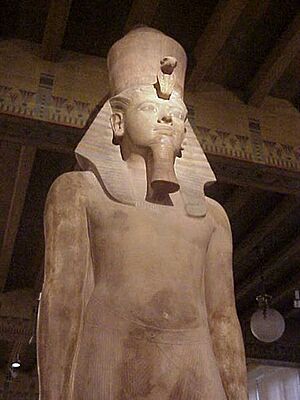
As part of bringing back the old religion, Tutankhamun started many building projects. He worked on the great temple at Karnak in Thebes. He built an avenue of sphinxes (statues with a lion's body and a human or animal head). These sphinxes led to the temple of the goddess Mut. At the Luxor temple, he finished decorating an entrance hall. He ordered new statues of the gods and new special boats, called barques, for religious parades. These boats were made from fine cedar wood and decorated with gold and silver.
Many of Tutankhamun's building projects weren't finished when he died. Later pharaohs, especially Horemheb, completed them. Sometimes they even put their own names on them.
Worshipped as a God

In ancient Egypt, pharaohs were usually worshipped as gods after they died. But Tutankhamun was one of the few pharaohs who was worshipped like a god even while he was alive. Temples for his worship were built far away, even in Kawa and Faras in Nubia (a land south of Egypt). This shows that many people saw him as a divine, or god-like, ruler. A song written on a stone tablet praises Tutankhamun as if he were a god.
Military Action
When Tutankhamun became pharaoh, Egypt was not as strong as it had been. Its relationships with other kingdoms had suffered. Tutankhamun tried to fix this and make peace with kingdoms like the Mitanni. Gifts from other countries found in his tomb show he might have been successful. Even though he worked for peace, there were still battles. Writings in his mortuary temple tell about victories against Nubians and people from Asia. As far as we know, Tutankhamun's army was never defeated in battle during his reign.
Did Tutankhamun himself fight in these battles? It's hard to say. His tomb was filled with weapons like bows, swords, and shields. Many of these look like they were used. Paintings also show him fighting. However, because he was young and might have had health problems, some historians think he didn't fight himself. Other experts believe he was stronger than some people think. He might have joined his soldiers, at least to encourage them.
Tutankhamun's Health
Scientists have studied Tutankhamun's mummy a lot. They want to learn about his health and why he died so young. It's still a topic with much discussion. Tutankhamun was not very tall, about 5 feet 6 inches (167 cm). He had good teeth, with large front incisors and an overbite. This was common in his royal family. Clothes found in his tomb suggest he had a slim waist.
Health Problems
In 2005, scientists used a CT scan (a special X-ray machine) on Tutankhamun's mummy. The scans showed he might have had:
- A cleft palate (a small gap in the roof of his mouth).
- A mild curve in his spine (scoliosis).
- Problems with his feet. His left foot might have been a clubfoot (turned inward). He also had avascular necrosis (a condition where bone tissue dies) in some bones of his left foot. This could have made walking painful.
Many walking canes were found in his tomb. Some people think he needed them to walk because of his foot problems. However, the canes don't look very worn out. Canes were also a symbol of power in ancient Egypt. So, he might have had them for that reason.
DNA tests also showed that Tutankhamun had malaria several times. Malaria is a serious disease spread by mosquitoes. He had the most severe type of malaria.
Theories About His Death
For a long time, people wondered if Tutankhamun was murdered. This was because early X-rays showed bone pieces in his skull. But later CT scans showed these bone pieces were probably broken off when his mummy was unwrapped in modern times. Not from an injury when he was alive.
The CT scans did show that Tutankhamun had a bad break in his left leg. It was a compound fracture, meaning the bone broke through the skin. There were no signs that the leg had started to heal. Many experts now think Tutankhamun died from a combination of things. His broken leg could have gotten infected. He also had a severe case of malaria. His other health issues might have made him weaker too. Some think he might have broken his leg during a military campaign or in an accident.
What Tutankhamun Looked Like
People have always been curious about what ancient Egyptians really looked like. Scientists have tried to recreate Tutankhamun's face. They use computers and information from his skull. In 2005, three different teams of scientists used CT scans of Tutankhamun's skull. They made a model of his face. The results from the teams were quite similar. However, the reconstructed face didn't look exactly like the statues and masks of Tutankhamun.
There has also been discussion about what his skin color might have been. Ancient Egyptian art often shows people with a range of tan skin colors. It's hard to know for sure from a mummy. More recently, in 2023, researchers made a new facial reconstruction. This new version looked a lot like the one made in 2005. These reconstructions give us an idea, but we can never be completely certain what he looked like in real life.
Who Ruled After Tutankhamun?
Tutankhamun's two children died as babies. He was probably the last male in his direct royal family line. This meant there was no clear person, like a son, to become the next pharaoh. Some records suggest Tutankhamun had chosen Horemheb, his top army general, to be his heir.
However, after Tutankhamun died, his advisor Ay became the next pharaoh. Ay was an old man and had been a powerful official for a long time. He may have even married Tutankhamun's widow, Ankhesenamun. This would strengthen his claim to be king. It's Ay who is shown leading Tutankhamun's funeral ceremony. This was usually a job for the next pharaoh. Ay's rule was short. After he died, Horemheb finally became pharaoh.
Horemheb continued the work Tutankhamun had started. He fully brought back the old Egyptian religion and made the country stable again. He respected Tutankhamun and didn't damage his tomb. This was unusual, as pharaohs sometimes tried to erase the memory of earlier rulers. Horemheb didn't have a son to follow him. So he chose another military officer, Ramesses I, to be his heir. This started a new line of pharaohs. Ramesses I's grandson, Ramesses II, became one of Egypt's greatest and most famous kings.
The Amazing Discovery of Tutankhamun's Tomb
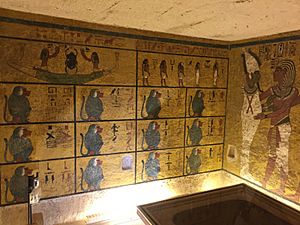
Tutankhamun was buried in the Valley of the Kings. This is where many pharaohs were laid to rest. But his tomb was quite small for a king. This might be because he died suddenly, before his big, fancy royal tomb was finished. So, he was buried in a smaller tomb. This was done so they could follow the tradition of burying a pharaoh within 70 days after death.
Long ago, robbers broke into his tomb at least twice. But they mostly took things like oils and perfumes. After these robberies, the tomb was resealed. Later, the entrance to his tomb got covered up by rocks and sand. This happened when workers were building other tombs nearby. Huts for workers were even built on top of it. Because it was hidden so well, his tomb was lost for over 3,000 years!
Finding the Lost Tomb
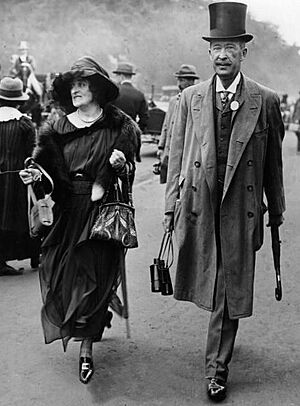
For many years, archaeologists searched for lost tombs in the Valley of the Kings. An archaeologist named Howard Carter was determined to find Tutankhamun's tomb. He was working for a rich British man named Lord Carnarvon, who paid for the search.
After searching for several years, on November 4, 1922, Carter's team found a step cut into the rock. It was hidden under old workers' huts. It was the entrance to a tomb! Carter knew this could be it. He carefully cleared the stairs and found a sealed doorway with Tutankhamun's name on it. In February 1923, Carter, Lord Carnarvon, and a few others made a small hole in the door. Carter looked inside. When asked if he could see anything, Carter famously said, "Yes, wonderful things!"
What Was Inside the Tomb?
Tutankhamun's tomb (known as KV62) is incredibly special. It was found almost completely untouched. It's the most complete ancient Egyptian royal tomb ever discovered. Inside, there were over 5,000 amazing objects! These included:
- Tutankhamun's mummy, resting inside a set of coffins. The innermost coffin was made of solid gold!
- The famous golden burial mask that covered the mummy's head and shoulders.
- Golden thrones and chariots.
- Statues, jewelry, and weapons like bows and daggers. One dagger even had a blade made from iron that came from a meteorite!
- Everyday items like furniture, clothes, games, food, and wine.
It took Howard Carter and his team 10 years to carefully record and remove everything from the tomb. Many of the items seemed to have been made for other pharaohs. They were then changed for Tutankhamun's burial. This also suggests his death was unexpected.
Today, Tutankhamun's mummy is back in his tomb in the Valley of the Kings. It's kept in a special glass case with climate control to protect it. The tomb itself was restored and reopened to visitors in 2019.
The "Curse of the Pharaohs"

After the tomb was opened, some people who had been involved in the discovery died. Lord Carnarvon died about five months later from an infection. This led to stories in newspapers about a "curse of the pharaohs". It was said to bring bad luck or death to anyone who disturbed a pharaoh's tomb.
However, most experts don't believe in a curse. Lord Carnarvon was not in good health before he went to Egypt. A study showed that out of 58 people who were there when the tomb was opened, only eight died within the next 12 years. This wasn't unusual for that time. Howard Carter himself lived for many more years, until 1939. The stories about the curse were probably made up to sell more newspapers and add excitement.
Why Is Tutankhamun So Famous Today?

Tutankhamun is one of the most famous pharaohs. But not because he was a great warrior or ruled for a very long time. He's famous mostly because his tomb was discovered so well-preserved. It was filled with incredible treasures. As one writer said, "The pharaoh who in life was one of the least esteemed of Egypt's Pharaohs has become in death the most renowned."
When his tomb was found in the 1920s, it was huge news all over the world. People became fascinated with ancient Egypt. Tutankhamun got the nickname "King Tut." Egyptian styles became popular in fashion and art. There were even songs about him, like "Old King Tut" in 1923. Much later, in 1978, comedian Steve Martin had a hit song called "King Tut." The name "King Tut" has been used for all sorts of things. Even a U.S. President, Herbert Hoover, had a dog named King Tut!
Treasures Travel the World
The amazing artifacts from Tutankhamun's tomb have traveled to museums in many countries. This allows millions of people to see them. These exhibitions have been incredibly popular. The first big international exhibition was in Paris in 1962. It drew over a million visitors. This helped start a new wave of interest in Tutankhamun. Another famous tour, called The Treasures of Tutankhamun, took place from 1972 to 1979. It went to cities in the United Kingdom, the United States, and other countries. Millions of people lined up to see the golden mask and other treasures.
More recently, there have been other tours. These include Tutankhamun and the Golden Age of the Pharaohs starting in 2005. Also, "King Tut: Treasures of the Golden Pharaoh" which began in 2019. These exhibitions usually include many items from Tutankhamun's tomb. Sometimes, his famous golden mask is not included in the tours to protect it.
These exhibitions help people learn about ancient Egyptian history and art. Soon, all of Tutankhamun's treasures will have a permanent home. They will be in the new Grand Egyptian Museum in Cairo, Egypt.
Interesting Facts About Tutankhamun
- Tutankhamun changed his name from Tutankhaten. His old name meant "living image of Aten." He wanted his new name to show his support for the god Amun.
- King Tut liked to hunt ostriches. He made a fan with their feathers.
- He had a club foot and owned over 100 walking sticks.
- No one knows exactly why he died so young.
- He has the smallest royal tomb in the Valley of the Kings. This is likely because he died unexpectedly and his tomb was not ready.
- He was laid in three nested golden coffins (like a set of Russian dolls).
- King Tutankhamun's tomb is one of the smallest found in the Valley of the Kings. It has only four chambers and an entrance staircase and corridor.
- The tomb of Tutankhamun is in higher demand from tourists than any other in the Valley of the Kings. Up to 1,000 people pass through it on its busiest days.
Images for kids
See also
 In Spanish: Tutankamón para niños
In Spanish: Tutankamón para niños


